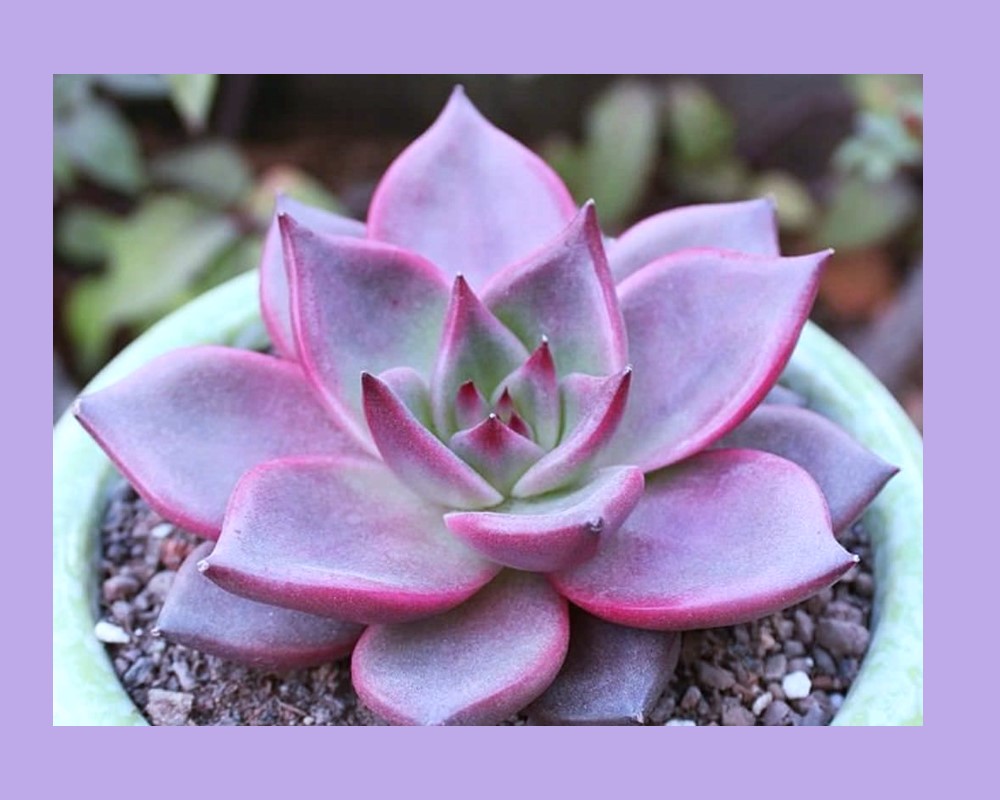purple Echeveria succulents like some cultivars of Echeveria purple pearl, Purple Echeveria agavoides, Purple Echeveria gibbiflora, Echeveria perle von nurnberg, Echeveria black Prince’, and Echeveria ‘Dark Moon” are best purple Echeveria types.
Here, you will find all the things required to provide an indoor plant collection of these stunning small succulents. I will show pics of the above purple Echeveria plants and tell you about the key characteristics.
In addition, I provided a guideline to care for these purple Echeveria types indoors. By following my tips, they will thrive healthy in your house and you will enjoy their beauties.
Purple Echeveria Types: Mauve Diamonds in your House
1- Purple Echeveria agavoides

You can find it with other names like Wax Echeveria, Wax Agave, Molded Wax Plant, and Molded Wax Agave. These common names are due to the plant’s waxy, sculpted appearance.
Echeveria agavoides is a popular succulent known for its striking, rosette-shaped form.
Purple Tendencies in Echeveria agavoides
While the typical Echeveria agavoides boasts green leaves with reddish tips, a natural variation in colouration can sometimes lean towards purple. However, it’s important to note that a deep, consistent purple colour is not a defining characteristic of this species.
Factors Influencing Purple Colouration:
- Sunlight: Increased exposure to sunlight can intensify the red tips of Echeveria agavoides, sometimes giving them a purplish hue.
- Cultivar Variations: Some specific cultivars of Echeveria agavoides might have a greater tendency towards purple colouration.
- Growing Conditions: Stressful conditions like drought or nutrient deficiencies can also influence leaf colour.
Light Purple Echeveria Types
2- Purple Echeveria gibbiflora

This lovely plant is also known as Mexican Giant Echeveria (due to its large size), Flor de Copal (Spanish). Please note that there are numerous cultivars and hybrids of Echeveria gibbiflora, each with its own unique characteristics. These variations often have specific names or designations.
Echeveria gibbiflora is a magnificent succulent known for its large, often ruffled rosette of leaves. It’s popular among succulent enthusiasts for its striking appearance and potential size.
Purple Hues in Echeveria gibbiflora
While not typically associated with deep purple tones, certain conditions can influence Echeveria gibbiflora to exhibit purplish hues.
- Sunlight: Intense sunlight can cause the leaf tips to blush pink or even take on a reddish or purplish tint.
- Cultivar Variations: Some cultivars of Echeveria gibbiflora might have a greater propensity for developing purplish tones.
- Stress: Under stress, such as drought or nutrient deficiency, the plant might produce anthocyanins, pigments that give leaves a reddish or purplish colour.
However, it’s essential to note that a deep, consistent purple colour is not a defining characteristic of Echeveria gibbiflora. If you’re seeking a plant with predominantly purple foliage, other Echeveria species or cultivars might be a better fit.
Popular Cultivars:
Echeveria gibbiflora ‘Metallica’: Known for its metallic sheen, and often exhibits reddish or purplish tones in its leaves.
3- Purple Echeveria perle von nurnberg : A Purple Gem

It’s a beautiful Purple Echeveria, which you can find with common names like Pearl of Nuremberg, Perle de Nuremberg (French), and Perla de Nuremberg (Spanish).
This is a cultivar, which means it’s a specific variety selected and propagated for its desirable traits. It’s a hybrid of Echeveria gibbiflora ‘Metallica’ and Echeveria elegans.
Echeveria ‘Perle von Nurnberg’ is renowned for its stunning colouration, which includes a captivating blend of purple, pink, and grey tones.
Purple Hues in Perle von Nurnberg
Natural Colouration: The plant naturally exhibits a beautiful interplay of pink and purple hues on its fleshy leaves.
- Sun Exposure: Increased sunlight intensifies the purple tones, making the colours even more vibrant.
- Seasonal Variations: The intensity of the purple colour can fluctuate with the seasons.
While not a deep, solid purple like some other Echeveria varieties, Perle von Nurnberg’s delicate blend of colours, including purple, makes it a beloved choice among succulent enthusiasts.
Dark Purple Echeveria Types
4- Dark Purple Echeveria purple pearl

Echeveria ‘Purple Pearl’ (Purple Perle Von Nürnberg). You can distinguish it from the Echeveria Perle von Nurnberg by its more vibrant, bigger, and thicker leaves which are deeper and spoon-shaped.
Echeveria ‘Purple Pearl’ is a captivating succulent renowned for its deep, rich purple colouration. Its leaves are typically thick and fleshy, and form a beautiful rosette shape. This striking hue sets it apart from many other Echeveria varieties. (Read my other post about Dark Purple houseplants.)
Key Characteristics:
- Deep purple colour: The plant’s most distinctive feature is its intense purple hue.
- Fleshy leaves: Like most Echeverias, it has thick, succulent leaves.
- Rosette growth pattern: The leaves grow in a circular pattern, forming a rosette.
Care Requirements:
- Light: Prefers bright, indirect light.
- Watering: Allow soil to dry completely between waterings to prevent root rot.
- Soil: Well-draining soil is essential.
- Temperature: Thrives in warm temperatures but can tolerate cooler conditions.
While the name suggests a deep, consistent purple colour, the actual shade can vary depending on factors like sunlight, temperature, and overall plant health.
5- Dark Purple Echeveria black knight

It is also known as Black Knight Echeveria. While sometimes this lovely succulent is referred to as Echeveria ‘Black Knight’, the correct scientific name includes the species affinis as well. It’s a cultivar of Echeveria affinis, known for its dark, almost black foliage.
Echeveria ‘Black Knight’ is a striking succulent known for its deep, almost black foliage. This dramatic colouration, combined with its rosette growth pattern, makes it a popular choice among plant enthusiasts.
Key Characteristics:
- Dark colouration: The plant’s leaves are typically a deep, dark green to almost black, giving it its name.
- Rosette growth: The leaves grow in a circular pattern, forming a beautiful rosette.
- Fleshy leaves: Like most Echeverias, it has thick, succulent leaves.
6- Dark Purple Echeveria Black Prince’

It is another hybrid of Echeveria affinis, but it has wider, shorter, more compact leaves than ‘Black Knight’.
Echeveria ‘Black Prince’ is a captivating succulent renowned for its deep, almost black foliage. Its dramatic colouration, combined with its rosette growth pattern, makes it a standout in any succulent collection.
Key Characteristics:
- Dark colouration: The plant’s leaves are typically a deep, dark green to almost black, giving it its name.
- Rosette growth: The leaves grow in a circular pattern, forming a beautiful rosette.
- Fleshy leaves: Like most Echeverias, it has thick, succulent leaves.
While the name suggests a deep, consistent black colour, the actual shade can vary depending on factors like sunlight, temperature, and overall plant health.
Blue Purple Echeveria Types
7- Echeveria ‘Dark Moon”: A Striking Blue-Purple Beauty

It is an elegant type of blue-purple Echeveria. Echeveria ‘Dark Moon’ is indeed a captivating succulent known for its elegant blue-purple hues. This cultivar stands out with its unique colouration, making it a prized addition to any succulent collection.
Key Characteristics:
- Distinctive Colouration: Its leaves boast a mesmerising blend of blue and purple tones, creating a striking contrast.
- Rosette Form: Like most Echeverias, it forms a beautiful rosette shape.
- Compact Size: Dark Moon typically maintains a compact growth habit.
To maintain the vibrant blue-purple colour, ensure your Dark Moon receives ample sunlight. However, avoid exposing it to intense, direct sunlight for extended periods, as this can cause sunburn
Purple Echeveria Care
Purple Echeverias, like their green counterparts, are relatively low-maintenance plants. However, understanding their specific needs will help them thrive and maintain their vibrant colouration.
General Care Tips
- Light: Most purple Echeverias love bright, indirect light. This helps intensify their colour. Avoid direct sunlight, especially during the hottest part of the day, as it can cause sunburn.
- Watering: Allow the soil to dry completely between waterings. Overwatering is a common cause of problems.
- Soil: Use a well-draining succulent or cactus mix. This prevents waterlogged roots.
- Potting: Choose a pot with drainage holes to facilitate proper water drainage.
- Temperature: Most Echeverias prefer warm temperatures, but they can tolerate cooler conditions as well. Avoid freezing temperatures.
Specific Care for Purple Echeverias
- Encourage Purple Colouration: While genetics plays a role, increasing light exposure can often intensify the purple hue.
- Protect from Frost: Purple Echeverias are generally sensitive to frost, so bring them indoors or protect them during cold weather.
- Fertilise Sparingly: Use a balanced, diluted fertiliser during the growing season (spring and summer). Over-fertilisation can harm the plant.
Common Issues and Solutions
- Overwatering: Leads to root rot. Symptoms include soft, mushy leaves. Reduce watering and ensure proper drainage.
- Underwatering causes shrivelled leaves. Increase watering frequency but avoid overwatering.
- Sunburn: Brown or scorched leaves indicate too much direct sunlight. Provide shade during peak sun hours.
While these are general guidelines, specific care needs can vary depending on the exact Echeveria variety. Observing your plant and making adjustments as needed will help ensure its health and beauty.
Conclusion
Echeveria ‘Dark Moon’, Echeveria Black Prince’, Echeveria purple pearl, Echeveria perle von nurnberg, Purple Echeveria gibbiflora, or Purple Echeveria agavoides: among these purple Echeveria types, which one is more interesting for your house?
I love Echeveria Echeveria ‘Dark Moon”. It’s an elegant combination of blue and purple hues. Anyway, if you are interested in blue Echeveria types, I discussed them in my other post. I tried to tell you some tips about their care and show you how to keep their purple hues.
Please tell me about your experiences and your favourite Echeveria types in the comments. You can also ask me your questions; I will answer as soon as possible.

Elahe Rabiei
Hi, I’m Elaheh. My Academic major is plant protection, and houseplants are my expertise. As a houseplant lover, my house is full of indoor plants and it is my passion to take care of them. Hence, I’m here to share my knowledge and experience about growing healthy houseplants. I am also a plant protection advisor, so feel free to ask me any questions you may have.

